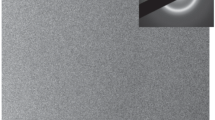Abstract
X-ray amorphous ribbons of aluminum-based alloys doped with transition (Ni, Fe) and rare earth (La) metals in various ratios were obtained by melt spinning. The mechanical characteristics and fracture surfaces of the ribbons under conditions of uniaxial tension with speeds from 0.01 to 10 mm/min were studied. It was shown that, with an increase in the rate in all investigated alloys, the strength limit increases and low plasticity remains. Inhomogeneous deformation is realized by the initiation and spread of shear bands. The mixed fracture surface indicates a brittle-viscous fracture with a high ratio of the viscous component. A significant influence of the scale factor on the strength characteristics of the ribbons was confirmed. The tensile strength of the ribbons increases with rising iron content and decreasing nickel content when the influence of the scale factor is excluded. It is experimentally shown on ribbons with a low-melting tin coating that local heating in shear bands reaches the melting point of tin of 231.9°C.








Similar content being viewed by others
REFERENCES
Kim, Y.-H., Inoue, A., and Masumoto, T., Increase in mechanical strength of Al–Y–Ni amorphous alloys by dispersion of nanoscale fcc-Al particles, Mater. Trans., JIM, 1991, vol. 32, no. 4, pp. 331–338.
Wang, L., Ma, L., Kimura, H., and Inoue, A., Amorphous forming ability and mechanical properties of rapidly solidified Al–Zr–LTM (LTM = Fe, Co, Ni, and Cu) alloys, Mater. Lett., 2002, vol. 52, pp. 47–52.
Polmear, I.J., Light Alloys: From Traditional Alloys to Nanocrystals, Amsterdam: Butterworth-Heinemann, 2006.
Glezer, A.M. and Molotilov, B.V., Struktura i mekhani-cheskie svoystva amorfnykh splavov (Structure and Mechanical Properties of Amorphous Alloys), Moscow: Metallurgiya, 1992.
Suryanarayana, C. and Inoue, A., Bulk Metallic Glasses, Boca Raton: CRC, 2010.
Kim, Y.-H., Inoue, A., and Masumoto, T., Ultrahigh mechanical strengths of Al88Y2Ni10 – xMx (M = Mn, Fe or Co) amorphous alloys containing nanoscale fcc-Al particles, Mater. Trans., JIM, 1991, vol. 32, no. 7, pp. 599–608.
Bakhteeva, N.D., Vasil’ev, A.L., Volkov, P.A., Ivanova, A.G., and Todorova, E.V., Specific features of sample preparation from amorphous aluminum alloys for transmission electron microscopy, Crystallogr. Rep., 2011, vol. 56, no. 3, pp. 463–469.
Bakhteeva, N.D., Todorova, E.V., Volkov, P.A., and Vasil’ev, A.L., Thermal stability of Al–Ni–Fe–La aluminum amorphous alloys, Russ. Metall. (Metally), 2012, no. 5, pp. 404–414.
Bakhteeva, N.D., Vasiliev, A.L., and Kannykin, S.V., Evolution of Al85Ni5Fe4La3 amorphous alloy structure under flash lamp annealing, Inorg. Mater., 2019, vol. 10, no. 2, pp. 260–270.
Sudzuki, K., Fudzimori, H., and Hasimoto, K., Amorfnye metally (Amorphous Metals), Moscow: Metallurgiya, 1987.
Fridman, Ya.B., Mekhanicheskie svoystva metallov (Mechanical Properties of Metals), Moscow: Mech. Eng., 1974, vol. 1.
Kuzey, A.M. Strukturno-fazovye prevrashcheniya v bystrozakalennykh alyuminievykh splavakh (Structural-Phase Transformations in Rapidly Quenched Aluminum Alloys), Minsk: Belarus. Sci., 2011.
Molokanov, V.V., Chueva, T.R., Umnova, N.V., Umnov, P.P., and Krutilin, A.V., Bending failure of “thick” Co-based-alloy amorphous wires, Russ. Metall. (Metally), 2019, no. 4, pp. 409–414.
Shtiba, S. and Varlimont, G., Bystrozakalennye metallicheskie splavy (Rapidly Quenched Metal Alloys), Moscow: Metallurgiya, 1989.
Levandovski, J.J. and Greer, A.L., Temperature rise at shear bands in metallic glasses, Nat. Mater., 2006, vol. 5, no. 1, pp. 15–18.
Bruck, H.A., Rosakis, A.J., and Johnson, W.L., The dynamic compressive behavior beryllium bearing bulk metallic glasses, J. Mater. Res., 1996, vol. 11, no. 2, pp. 503–511.
Yang, B., Liaw, P.K., Wang, G., et al., In-sity thermographic observation of mechanical damage in bulk-metallic glasses during fatigue and tensile experiments, Intermetallic, 2004, vol. 12, nos. 10–11, pp. 1265–1274.
Funding
This work has been carried out in accordance with the state order no. 075-00947-20-00.
Author information
Authors and Affiliations
Corresponding authors
Additional information
Translated by Sh. Galyaltdinov
Rights and permissions
About this article
Cite this article
Bakhteeva, N.D., Todorova, E.V., Prosvirnin, D.V. et al. Low-Temperature Deformation of Al–Ni–Fe–La System Amorphous Alloys. Inorg. Mater. Appl. Res. 12, 509–516 (2021). https://doi.org/10.1134/S2075113321020076
Received:
Revised:
Accepted:
Published:
Issue Date:
DOI: https://doi.org/10.1134/S2075113321020076




